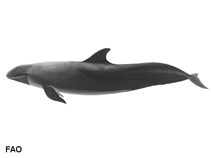Pseudorca crassidens (Owen, 1846)
False killer whale| Native range | All suitable habitat | Point map | Year 2050 |

|
| This map was computer-generated and has not yet been reviewed. |
| Pseudorca crassidens AquaMaps Data sources: GBIF OBIS |
Классификация / Names народные названия | синонимы | CoL | ITIS | WoRMS
Mammalia | Cetartiodactyla | Delphinidae
Environment: milieu / climate zone / пределы глубины / distribution range экология
пелагический; мигрирует в океане (ссылка 75906); пределы глубины 0 - 2332 m (ссылка 116169). Tropical; 90°N - 90°S, 180°W - 180°E
Distribution страны | регионы FAO | Ecosystems | места находок | интродукции
Atlantic Ocean, Mediterranean and Indo-Pacific. Tropical to warm temperate.
Length at first maturity / Size / Weight / Возраст
половая зрелость: Lm ?, range 366 - 427 cm Max length : 600 cm TL самец/пол неопределен; (ссылка 1394); 500 cm TL (female); наибольший вес (опубликованные данные): 2.0 t (ссылка 1394)
Life cycle and mating behavior половая зрелость | размножение | нерест | Eggs | Fecundity | Larvae
Основная ссылка
ссылки | координатор | соавторы
Tan, J.M.L. 1995 A Field Guide to the Whales and Dolphins in the Philippines. Makati City: Bookmark. 125 p. (ссылка 936)
Статус Красного Списка МСОП
(ссылка 130435: Version 2025-1)
Статус СИТЕС (ссылка 108899)
CMS (ссылка 116361)
Угроза для людей
Использование человеком
рыболовство: коммерческий
FAO - рыболовство: landings, Видовой профиль | FishSource | Sea Around Us
инструменты
дополнительная информация
ресурсы в Интернет
BHL | BOLD Systems | CISTI | DiscoverLife | FAO(рыболовство: Видовой профиль; publication : search) | Fishipedia | GenBank (Геном, Нуклеотид) | GloBI | Gomexsi | Google Books | Google Scholar | Google | PubMed | Tree of Life | Wikipedia (Вперёд, поиск) | Zoological Record



